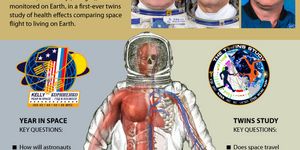Astronaut Scott Kelly will be spending a year on the International Space Station to study the effects of long-duration space missions on the human body. He'll be paired with Russian cosmonaut Mikhail Kornienko, who will be with him on the ISS, but, in a way, he'll also be paired with someone else: his twin brother, Mark Kelley. Mark, also an astronaut, will be here on Earth as a sort of control subject.

Kelly and Kornienko's year-long mission will be the longest so far on the International Space Station. It will not be the longest space mission ever. That record is held by Russian Cosmonaut Valeri Polyakov, who spent 437.7 days on the now defunct Russian space station Mir from 1994 though 1995. Kelley's mission will, however, be the first mission of its type, with one twin in space for a year and the other here on Earth.
In order for humans to undertake a space mission anywhere beyond the Moon, astronauts will most likely have to spend long periods of time in space. Current plans for a trip to Mars, for example would require eleven months in space. What happens to the human body when it spends that kind of time in a weightless environment? Could a team of astronauts still be in shape to carry out a mission on the surface of Mars after enduring such prolonged periods in zero gravity? What will the effects of isolation, radiation, zero-g exercise, and a diet of space rations do to the human body and mind over the course of a year in space? And how does, for all intents and purposes, a copy of an astronaut who remains here on Earth compare to his twin in space during that time? These are all questions that will be addressed during Kelly and Kornienko's mission.
Scientists who will be observing the Kelley twins will be studying the pair's epigenetics, meaning the way DNA expresses itself in different environments and under different conditions. Scott Kelly, the twin who will be going into space, will take blood samples and send them back to earth with each returning ship during his one-year stay. Meanwhile, his earthbound twin, Mark will provide samples of his own. Each time scientists will compare the two sets of samples. The twins will also undergo a series of analog psychological and cognitive tests. Scientists are particularly interested in the effects on the pulmonary and respiratory systems, as well as the effects of long-term space missions on eyesight. It is extremely important that astronauts have good vision. Needing to adjust your glasses inside your space helmet could be a real problem.
"Obviously, this is a tiny sample size," says Andrew Feinberg, one of the scientists who will be studying the twins, "so we're not really looking at how Scott and Mark are different during the year, exactly. It's not statistically valid to say that differences between them must be due to the spaceflight."
So, Feinberg and his team will be watching how each brother changes over the course of the year.
"If something happens after Scott departs," Feinberg says, "increases during his trip, and then goes back to normal after he comes back to Earth - if we don't see that kind of sequential change in his twin, well, it's not proof of anything, but it certainly suggests something interesting is going on."
"NASA is working on this science project that's the greatest in the history of civilization," the clearly excited Feinberg continues. "They're turning humankind from an Earth-dwelling species into a space-exploring species. One day, humankind will be a species that can settle on other planets. It might be a hundred years before we have humans living on Mars, but this is a whole new kind of science."
(Source: The Washington Post)









